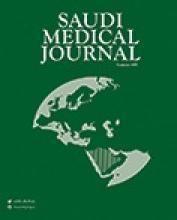No disease has attracted attention in the last 2 decades all over the world, such as osteoporosis. Being a silent disease with high prevalence among older population, the battle is difficult. The situation is not different in the Kingdom of Saudi Arabia (KSA). An epidemiological analysis showed that 34% of healthy Saudi women, and 30.7% of men, 50-79 years of age are osteoporotic.1 With a reported increased life expectancy in KSA increasing from 45-67 years in 1960 to 75.7 years in 2013,2 the prevalence of osteoporosis is expected to increase even further. Lifestyle factors play a significant role in the high prevalence of this disease, with low calcium intake, lack of physical activity, and a higher prevalence of vitamin D deficiency, being among the main culprits. In KSA, there is approximately 8,768 femoral fractures each year costing billions, and being an endemic area for vitamin D deficiency, bone health is becoming a serious concern in the kingdom.
Correct interpretation of bone mineral density measurements by dual energy x-ray absorptiometry (DEXA) requires a population-specific reference range. Currently, we are using Western software in our DEXA machines. Does this affect the accuracy of diagnosing patients?
Where are we from improving osteoporosis awareness among physicians?
After 12 years of practicing hospital based osteoporosis practice, I still find under and over- diagnosis referrals to be common. When I see an elderly on high steroid dose for many years referred only after suffering multiple fractures or a 40-years old woman without any risk factor who is referred as a case of osteoporosis because her bone density is low, I realize how silent the disease can be for both patients and doctors, and that we are miles away from achieving optimal care. It is worth mentioning that these are not uncommon situations in our practice. The notes cited above are not meant to downgrade other specialties; rather, it emphasizes the point that the quality of care needs urgent intervention by multidisciplinary health care teams and professional organizations to improve awareness.
What can we do to improve osteoporosis care?
The Saudi Osteoporosis Society adopted the mission of providing health care providers with evidence based learning in the field of osteoporosis through organizing annual courses and conferences. A mandatory vitamin D fortified milk products (such as Laban, a common drink in KSA) policy is needed. Establishing such policy requires collaboration of MOH with SOS and the major dairy products companies.
The clinical decision to treat or not treat patients with osteopenia mandates using the Fracture Risk Assessment Tool (FRAX) developed by the World Health Organization.3 The FRAX calculator combines a set of clinical risk factors with country-specific incidence rates to determine the ten-year absolute risk of major osteoporotic fracture. However, regional or country-specific databases from KSA are not available. To get hold of that, a steering group must be set up to drive the establishment of a National Hip Fracture Registry. The group should be supported by funds and dedicated members to roll up their sleeves, and undertake the groundwork needed to make it happen.
A growing body of published literature suggests that provision of secondary preventative care post-hip fracture (osteoporosis assessment/treatment and falls prevention strategies) is not routinely delivered.4
The time has come to implement the internationally well-established Fracture Liaison Services (FLS). This is a coordinator-based, secondary fracture prevention service designed to close the care gap for fracture patients, 80% of whom are currently never offered screening and/or treatment for osteoporosis. It enhances the communication between health care providers (endocrine, orthopedics, trained nurse) by providing a care pathway for the treatment of fragility fracture patients.5 Osteoporosis will continue to be unabated unless concerned institutions combine their effort, and start applying national positive actions to improve osteoporosis awareness, screening, prevention, and treatment.
Related Articles
Albogami MM, Jawad AS, Mageed RA. Bone loss in osteoporosis and arthritis. Pathogenesis and therapeutic strategies. Saudi Med J 2014; 35: 224-233.
Abdelkarem HM, Abd El-Kader MM, Kasem SA. Manipulation of flaxseed inhibits tumor necrosis factor-alpha and interleukin-6 production in ovarian-induced osteoporosis. Saudi Med J 2011; 32: 369-375.
Al-Shahrani FM, Al-Zahrani AM, Al-Haqawi AI. Knowledge of osteoporosis in middle-aged and elderly women. Saudi Med J 2010; 31: 684-687.
Al-Habdan IM, Sadat-Ali M, Al-Muhanna FA, Al-Elq AH, Al-Mulhim AA. Bone mass measurement using quantitative ultrasound in healthy Saudi women. A cross-sectional screening. Saudi Med J 2009; 30: 1426-1431.
- Received March 24, 2015.
- Accepted May 12, 2015.
- Copyright: © Saudi Medical Journal
This is an open-access article distributed under the terms of the Creative Commons Attribution-Noncommercial-Share Alike 3.0 Unported, which permits unrestricted use, distribution, and reproduction in any medium, provided the original work is properly cited.






